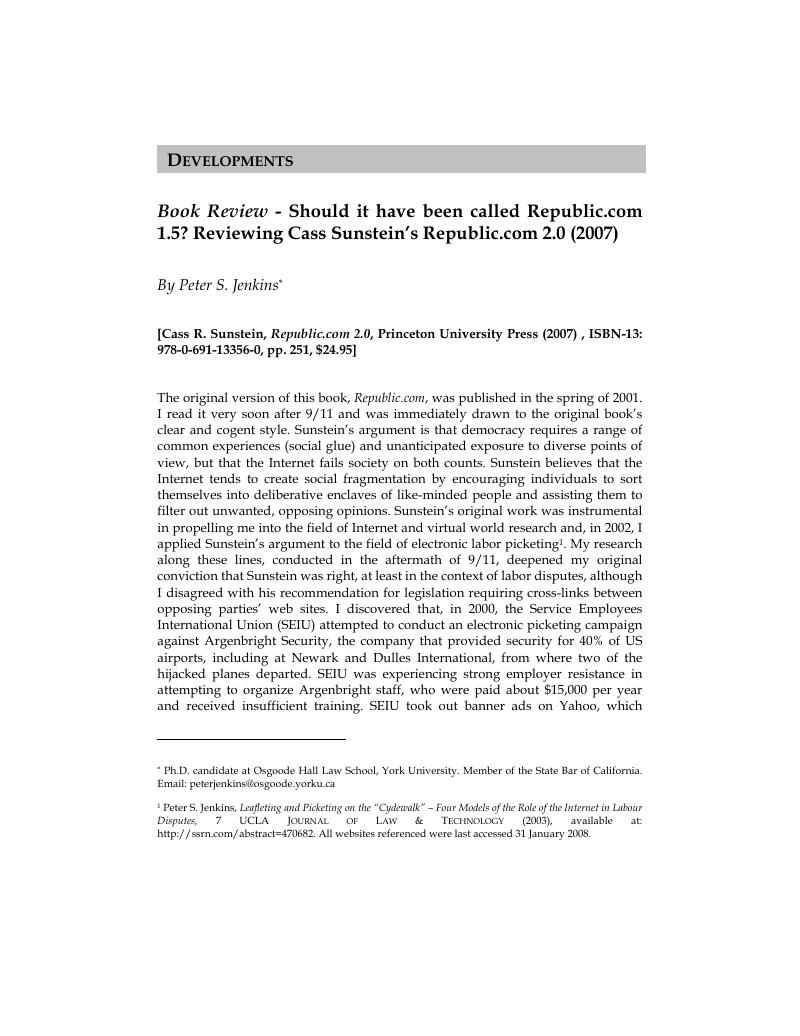No CrossRef data available.
Published online by Cambridge University Press: 06 March 2019

1 Peter S. Jenkins, Leafleting and Picketing on the “Cydewalk” – Four Models of the Role of the Internet in Labour Disputes, 7 UCLA Journal of Law & Technology (2003), available at: http://ssrn.com/abstract=470682. All websites referenced were last accessed 31 January 2008.Google Scholar
2 Labornet Newsline Yahoo! Cancels Banner Ads Placed by SEIU, 18 February 2000, available at: http://www.labornet.org/news/030100/05.html Google Scholar
3 Sunstein's tendency to avoid referring to many of his critics also extends into omitting the full context of important case law, where that context does not necessarily support his view. For example, in his discussion of the US Supreme Court case which required shopping mall owners to keep their property open for expressive purposes, Pruneyard Shopping Center v. Robbins, 447 U.S. 74 (1980), (SUNSTEIN, 180) he neglects to mention that the decision narrowly ruled on the interaction of the US Constitution and the California State Constitution, i.e. the former only provides for a negative command to Congress not to interfere with freedom of speech, while the latter provides for an affirmative right, and therefore the latter can provide supplementary rights as long as they do not interfere with federal constitutional rights. Hence, approximately half of the states in the US have the opposite result to California.Google Scholar
4 e.g. Nadel, Mark S., Customized News Services and Extremist Enclaves in Republic.com, 54 Stanford Law Review 831 (2002); Hunter, Dan, Phillipic.com, 90 California Law Review 611 (2002); Chander, Anupam, Whose Republic? 69:3 University of Chicago Law Review, 1479 (2002);Google Scholar
5 e.g. Fallows, James, He's Got Mail, 49 The New York Review of Books 4 (2002), available at: http://www.nybooks.com/articles/15180.Google Scholar
6 Is the Internet Good for Democracy? Boston Review (Summer 2001), available at: http://bostonreview.net/ndf.html#Internet.Google Scholar
7 Iyengar, Shanto and Morin, Richard, Red Media, Blue Media, Evidence of Ideological Polarization in Media Use, Annual Meeting of the International Communication Association (2007)Google Scholar
8 Jenkins, Henry, Challenging the Consensus – A Response to the Daily We, Boston Review (Summer 2001), available at: http://bostonreview.net/BR26.3/jenkins.html.Google Scholar
9 Henry Jenkins, Convergence Culture 238 (2006)Google Scholar
10 Garfinkel, Simson, The Mathematics of Growth – A Response to the Daily We, Boston Review (Summer 2001), available at: http://bostonreview.net/BR26.3/garfinkel.html.Google Scholar
11 McChesney, Robert W., Power to the Producers - A Response to the Daily We, Boston Review (Summer 2001), available at: http://bostonreview.net/BR26.3/mcchesney.html. McChesney points out, for example, in the 2000 US Presidential election, exit polls showed that the richest 20 percent of Americans accounted for 50 percent of all the voters.Google Scholar
12 Available at: http://www.infoplease.com/ipa/A0781453.html.Google Scholar
13 Sunstein, 197Google Scholar
14 See Mark Glaser, Human and Automated Aggregators Help Make Sense of Blogosphere, Online Journalism Review, Annenberg School of Journalism, University of Southern California (2005), available at: http://www.ojr.org/ojr/stories/050405glaser/ Google Scholar
15 Sunstein, 188Google Scholar
16 See, for example, Robert Bichler, Attention as a scarce resource in an information-based society, ICT&S Center, University of Salzburg (2005), available at: http://www.mdpi.org/fis2005/F.04.abstract.pdf Google Scholar
17 Sunstein, 210Google Scholar
18 See the Wikipedia biography of Kaczynski, Theodore, available at: http://en.wikipedia.org/wiki/Theodore_Kaczynski.Google Scholar
19 Cohen, Morris, The Basis of Contract, 46 Harvard Law Review 553 (1933)Google Scholar
20 Coase, Ronald H., The Theory of the Firm, 4 Economica 386 (1937)Google Scholar
21 Coase, Ronald H., The Problem of Social Cost, 3 Journal of Law and Economics 1 (1960)Google Scholar
22 Christine Jolls, Cass R. Sunstein and Richard H. Thaler, A Behavioral Approach to Law and Economics, in Behavioral Law & Economics, 13, 18 (Cass R. Sunstein, ed., 2000)Google Scholar
23 Sunstein, Infotopia – How Many Minds Produce Knowledge, 14, 118, 140, 156, 186, 221 (2006)Google Scholar
24 E.g. Yochai Benkler, The Wealth of Networks (2006) [reviewed by James Brink in 7 German L. J. 853 (2006), available at: http://papers.ssrn.com/sol3/papers.cfm?abstract_id=967505]; Tim Wu, Intellectual Property, Innovation and Decentralized Decisions, 92 Virginia Law Review 101 (2006).Google Scholar
25 This contrition was foreshadowed to some degree in the 2002 edition of Republic.com, which contained a new section entitled “Afterword” where Sunstein made some effort to characterize himself as not anti-Internet, although he did not withdraw any of his key original policy proposals.Google Scholar
26 Jürgen Habermas, Between Facts and Norms: Contributions to a Discourse Theory of Law and Democracy, 940 (1991)Google Scholar
27 Internet World Stats - North America Internet Users and Population Statistics, available at: http://www.internetworldstats.com/stats14.htm.Google Scholar
28 Internet World Stats – Internet Usage in Europe, available at: http://www.internetworldstats.com/stats4.htm.Google Scholar
29 Sunstein, 178.Google Scholar
30 Id., 238, n. 13.Google Scholar
31 Sunstein, Democracy and the Problem of Free Speech, 77 - 81 (1993)Google Scholar
32 Directive 2007/65/EC of the European Parliament and of the Council of 11 December 2007 amending Council Directive 89/552/EEC on the coordination of certain provisions laid down by law, regulation or administrative action in Member States concerning the pursuit of television broadcasting activities, available at: http://www.europarl.europa.eu/oeil/FindByProcnum.do?lang=2&procnum=COD/2005/0260.Google Scholar
33 Internet World Stats - Top Ten Languages Used in the Web, available at: http://www.internetworldstats.com/stats7.htm.Google Scholar
34 English in Computer Science, available at: http://en.wikipedia.org/wiki/English_on_the_Internet#English_on_the_Internet.Google Scholar
35 Getting Serious, Technology Quarterly, Economist.com (6 December 2007), available at: http://www.economist.com/opinion/displaystory.cfm?story_id=10202591 Google Scholar
36 Edward Castronova, Exodus to the Virtual World, 6 (2007)Google Scholar
37 The current stage, known as Web 2.0, arose with the relatively recent emergence of “grass roots” features such as wikis, blogs, YouTube and Facebook.Google Scholar
38 Jenkins, Peter S., The Virtual World as a Company Town – Freedom of Speech in Massively Multiple Online Role-Playing Games, 8 Journal of Internet Law 1 (2004), available at: http://papers.ssrn.com/sol3/papers.cfm?abstract_id=565181 Google Scholar
39 Hunter, Dan, Phillipic.com, 90 California Law Review, 611 (2002)Google Scholar
40 Edward Castronova, Exodus to the Virtual World, 180 (2007)Google Scholar
41 The presence of bots in the virtual world may also be necessary to avoid ethical problems. See, Jenkins, Peter S., Historical Simulations – Motivational, Ethical and Legal Issues, 11 Journal of Futures Studies 23, (2006), available at: http://papers.ssrn.com/sol3/papers.cfm?abstract_id=929327 Google Scholar
42 Castronova, (note 40) 181.Google Scholar